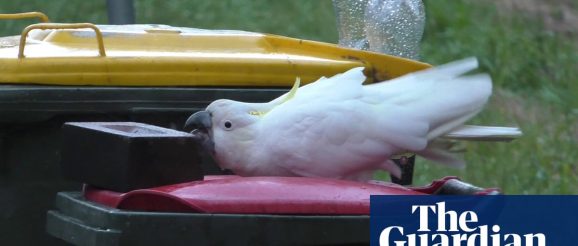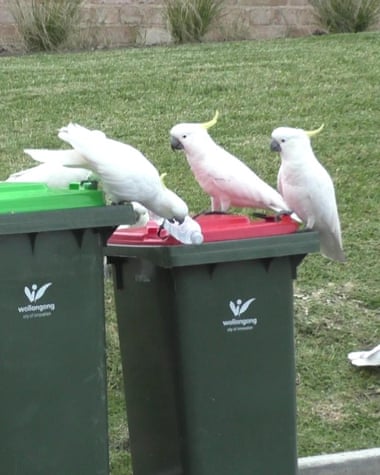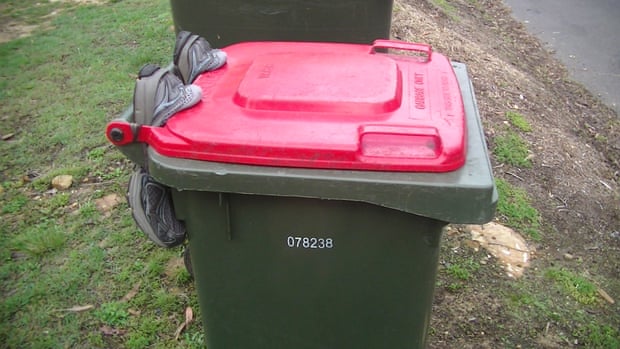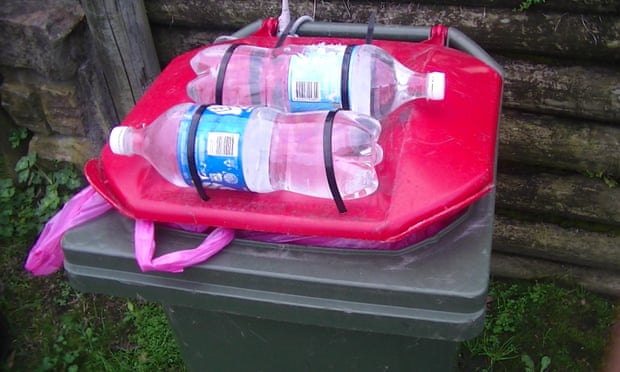‘Interspecies innovation arms race’: cockatoos and humans at war over wheelie bin raids | Sydney | The Guardian

Cockatoos and humans are locked in what Australian researchers have described as “an interspecies innovation arms race”.
Sydney residents are resorting to increasingly sophisticated measures to prevent sulphur-crested cockatoos from opening and raiding household wheelie bins, detailed in new research published in the journal Current Biology.
The study, led by Dr Barbara Klump of the Max Planck Institute of Animal Behavior in Germany, documented 52 combinations of techniques used by humans to deter the birds from their bin-raiding antics.

The researchers have previously described how cockatoos across the greater Sydney region learned their bin-opening skills from one another, with the behaviour spreading from sightings in three suburbs before 2018 to 44 suburbs by the end of 2019.
Attracted by food waste, the highly intelligent parrots use their beaks and manoeuvre themselves to swing bin lids open.
The researchers conducted a census of 3,283 bins across four Sydney suburbs. In Stanwell Park, where the bin raiding was most common, they noted that more than half of the bins had protection mechanisms in place.
They also surveyed more than 1,100 residents in the greater Sydney and Wollongong regions. Of the respondents, 172 people from 51 suburbs reported protecting their bins against cockatoos.
The challenge for humans is to secure the bins in a way that still allows them to be opened and emptied by automated garbage trucks.
The most basic cockatoo deterrent was the use of a brick or other heavy item to weigh down a lid. “We have definitely seen cockatoos frequently pushing those off,” said Dr Richard Major, a senior fellow at the Australian Museum and one of the study’s co-authors. “It’s a lot of fun watching a cockatoo pushing a brick off – you almost sense the satisfaction it gets as it does it.”

One survey respondent said: “Bricks seemed to work for a while, but cockies got too clever.”
One nifty solution was to wedge a pair of running shoes near the hinge of the bin lid. “When the bin truck lifts it up and turns it over, the lid is heavy enough to compress the sand shoe so that the lid can still open and dump rubbish,” Major said. “But [it] was a bit too much for a cockatoo to lift.”
Sign up to Guardian Australia’s Morning Mail
Our Australian morning briefing email breaks down the key national and international stories of the day and why they matter
Another successful technique was to strap full water bottles to the bin lid using zip ties. Some people tried putting rubber snakes on their bin lids, while others installed spikes around bin rims.
“The thing that this paper did was look seriously at the spatial variation in humans’ bin-opening solutions,” Major said. “Some of the techniques that people used appeared to be clustered spatially … some people would use the same technique as their neighbour.”
The researchers consider the bin standoff to be an “innovation arms race” that involves “learned behavioural change in two populations/species”.

“Cockatoos – because of their large brain size and their sociality – they’ve adapted brilliantly to living with humans. And I guess now, with this arms race, we’re showing that humans are adapting brilliantly to live with cockatoos,” Major said.
Sulphur-crested cockatoos are capable of dancing in time to music, one of few non-human species recognised to possess the ability. They are notorious in Australia for their cheeky behaviour and screeching.
Major said: “They’re a wonderful bird … beautiful, charismatic, but they’re also bloody annoying.”
